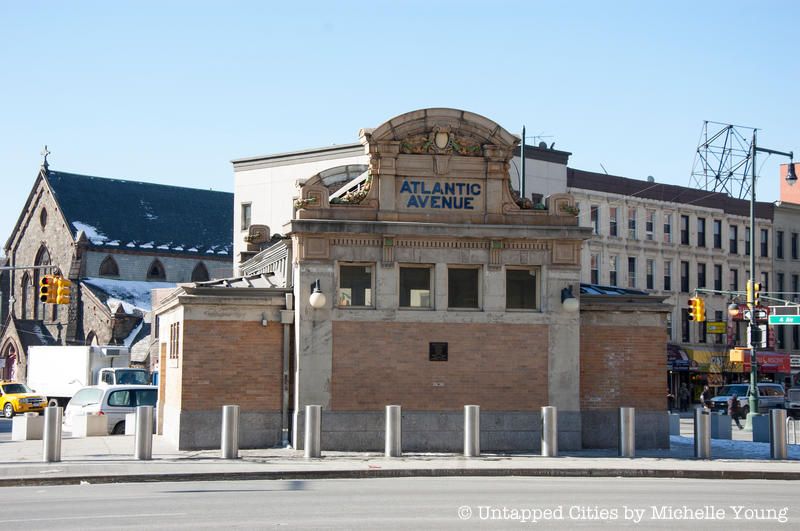Fiber Arts Take Over a Former Seaport Warehouse in NYC
See waterfalls of fabric, intricate threadwork, massive tapestries, and more!


The subway entrance above Brooklyn’s Atlantic Avenue-Barclays Center station has a secret wellspring of life inside: a three-piece art installation called Hook (Archean Reach), Line (Sea House), and Sinker (Mined Swell) by the artist George Trakas. Commissioned by MTA Arts & Design and created in collaboration with di Domenico and Partners, the pieces take up the entire original Beaux-arts fare control center and calls on the history of the area for inspiration. The centerpiece of the installation is a giant steel boat figure that floats above the sea of commuters.
Join Untapped New York for our upcoming Secrets of the Brooklyn Subway Tour to see this piece in person, uncover more hidden art underground, and peek into abandoned stations!
The preexisting configuration of subways and rails at the Atlantic Avenue-Barclays Center station, in conjunction with its location at the lip of the LIRR’s Terminal, presented the perfect challenge for a joint effort that incorporated both art and architecture. The space below the original kiosk, which was designed by Heins & LaFarge and constructed in 1908, is far taller and more spacious than it appears from the outside. Trakas and the architects collaborated on a redesign of the station in 2004 and made the spaces airier, with the installation of a skylight in the ceiling, and aesthetically cohesive with Trakas’ art.

From outside the above-ground kiosk, visitors can look through a peephole equipped with a lens to see the boat-shaped contraption made of stainless steel hanging just underneath the glass. This part of the installation is called Line (Sea House). The shape is both symbolic and practical as the steel structure serves as a rolling gantry that maintenance workers can access through a locked door and step onto in order to reach the lights floating high in the empty space above the station floor.

The art piece continues down from the lighthouse-like space into the subway station below as large panels of granite cover the walls. The panels are broken by a stair-shaped cut-out which serves to mark where the original staircase once stood in the 1908 structure. The granite stonework continues into Hook (Archean Reach), an undulating band that rolls like waves from the Pacific Street entrance to the tracks. The wave “crests” at the meeting place between the passageways that link Atlantic Avenue and Pacific Street. Sinker (Mined Swell) is a wide, rough-faced strip of granite that appears between the staircases connecting the main station exits and train tracks.

The project’s aquatic-inspired name recognizes the convergence of the two streets named after the two major oceans. In some ways, subway stations are like oceans, constantly moving and churning out tides on a regular schedule, and Brooklyn is at its heart a waterfront town. Hook, Line, and Sinker (the name for the entire work) takes note of these roots as well as its location’s contemporary needs to create a place that is at once a hub of travel and a still place in the midst of the rushing sea.
Trakas drew inspiration from sources as varied as the piazzas of Italian hill towns. A self-described environmental sculptor, Trakas was born in Quebec but has lived in New York City since 1963. He often uses recycled materials in his work and has designed a waterfront nature walk at the Newtown Creek Wastewater Treatment Plant in Brooklyn, among other installations.

Trakas’s innovative subway station design has opened a portal to the world above, serving as a way for passengers to orient themselves after being spun around several times by the frequently disorienting train rides. This portal allows for something especially rare to happen: on sunny days, the subway station fills with light from the skylight above, reminding travelers on the often stormy sea of New York City’s transit maze that there is a world outside the underground.

Uncover more surprising facts about the Brooklyn subway on our upcoming underground tour!
For more, check out 20 Examples of Original Subway Art
This article was originally written by Eden Gordon and updated by Nicole Saraniero
Subscribe to our newsletter